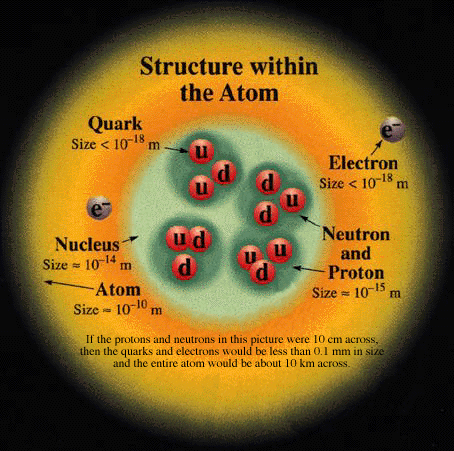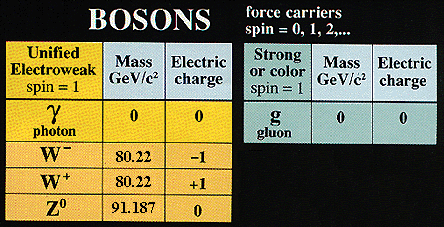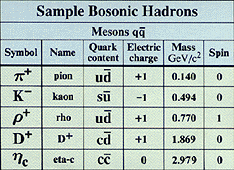Standard Model of Fundamental Particles and Interactions
The "Standard Model" is a term used to describe the quantum theory that includes the theory of strong interactions (quantum chromodynamics or QCD) and the unified theory of weak and electromagnetic interactions (electroweak). Gravity is included on this chart because it is one of the fundamental interactions even though not part of the "Standard Model"

Residual Strong Interactions
The strong binding of the color-neutral protons and neutrons to form nuclei is due to residual strong interaction between their color-charged constituents. It is similar to the residual electrical interaction which binds electrically neutral atoms to form molecules. It can be viewed as the exchange of mesons between the hadrons.

Top quark discovered

Color Charge
Each quark carries one of the three types of "strong charge", also called "color charge". These charges have nothing to do with the colors of visible light. There are eight possible types of color charge for gluons. Just as electrically charged particles interact by exchanging photons, the strong interactions color-charged particles exchange gluons. Leptons, photons, and W and Z bosons have no color charge and hence no strong interaction. One cannot isolate quarks and gluons, they are confined into color-neutral hadrons. This confinement (binding) results from multiple exchanges of gluons among the color-charged objects.
Confinement
As color-charged particles (quarks and gluons ) are separated, the color force between them approaches a constant value and the energy in the color-force field increases. The energy eventually is converted into additional quark-antiquark pairs. The objects that finally emerge are color-neutral combinations called hadrons (mesons and baryons).


Spin is the intrinsic angular momentum of particles. Spin is given in units of h-bar,
which is the quantum unit of angular momentum, where hbar=h/2pi = 6.58*10^-25 GeV s = 1.05*10^-34 J s.
Electric charges are given in units of the proton's charge. In SI units the electric charge of the proton is 1.60 * 10^-19 coulombs.
The energy unit of particle physics is the electron volt (eV), the energy gained by one electron in crossing a potential difference of one volt. Masses are given in GeV/c^2. ( Remember E = mc^2 ), where 1 GeV = 10^9 eV = 1.60 * 10^-10 joule. The mass of the proton is 0.938 GeV/c^2 = 1.67*10^-27 kg
Properties of the Interactions

Matter and Antimatter
For every particle type there is a corresponding antiparticle type, denoted by a bar
over the particle symbol. Particle and antiparticle have identical mass and spin but opposite charges. Some electrically neutral bosons (e.g, Z0, gamma, and eta_c = c
cbar but not K0 = ds) are their own antiparticles.
The diagrams are an artist's conception of physical processes. They are not exact and have no meaningful scale. Green shaded areas represent the cloud of gluons or the gluon field, red lines the quark paths, and black lines the paths of leptons.

A neutron decays to a proton, an electron, and an antinuetrino via a virtual
(mediating) W boson. This is neutron beta decay.

An electron and positron (antielectron) colliding at high energy can annihilate to
produce D+ and D- mesons via a virtual Z boson or a virtual photon.

The c and cbar quarks in an eta_c meson annihilate into virtual gluons. Quark pair
production in the gluon cloud sometimes gives a pi+, K0, and K- as the final products.
Contemporary Physics Education Project
The chart, from which the above information is extracted, was created by the Contemporary Physics Education Project. For information on materials prepared to supplement the chart (book, computer software, film, write CPEP, MS 50-308. Lawrence Berkeley Laboratory, Berkeley, CA 94730.

2-APR-95 by Peter Berglund
peter@neuro.hut.fi









